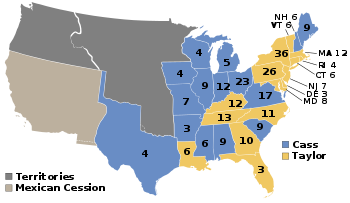United States presidential election, 1848
|
|
|||||||||||||||||||||||||||||||||||||||||||||||||||
|
|||||||||||||||||||||||||||||||||||||||||||||||||||
|
|||||||||||||||||||||||||||||||||||||||||||||||||||
|
|
|||||||||||||||||||||||||||||||||||||||||||||||||||
| Presidential election results map. Buff denotes those won by Taylor/Fillmore, blue denotes states won by Cass/Butler. Numbers indicate the number of electoral votes allotted to each state. | |||||||||||||||||||||||||||||||||||||||||||||||||||
|
|||||||||||||||||||||||||||||||||||||||||||||||||||
The United States presidential election of 1848 was the 16th quadrennial presidential election, held on Tuesday, November 7, 1848. It was won by Zachary Taylor of the Whig Party, who ran against Lewis Cass of the Democratic Party and former President Martin Van Buren of the newly formed Free Soil Party. Incumbent President James K. Polk, having achieved all of his major objectives in one term and suffering from declining health, kept his promise not to seek re-election.
The contest was the first presidential election that took place on the same day in every state, and it was the first time that Election Day was statutorily a Tuesday.
The Whigs in 1846–47 had focused all their energies on condemning Polk's war policies. They had to reverse course quickly. In February 1848 Polk surprised everyone with the Treaty of Guadalupe Hidalgo that ended the Mexican-American War and gave the United States vast new territories (including what are now the states of California, Nevada, Utah, and parts of Wyoming, Colorado, Arizona, and New Mexico). The Whigs in the Senate voted 2-1 to approve the treaty. Then, in the summer, the Whigs nominated the hero of the war, Zachary Taylor. While he did promise no more future wars, he did not condemn the Mexican-American War or criticize Polk, and the Whigs had to follow his lead. They shifted their attention to the new issue of whether slavery could be banned from the new territories.
...
Wikipedia




